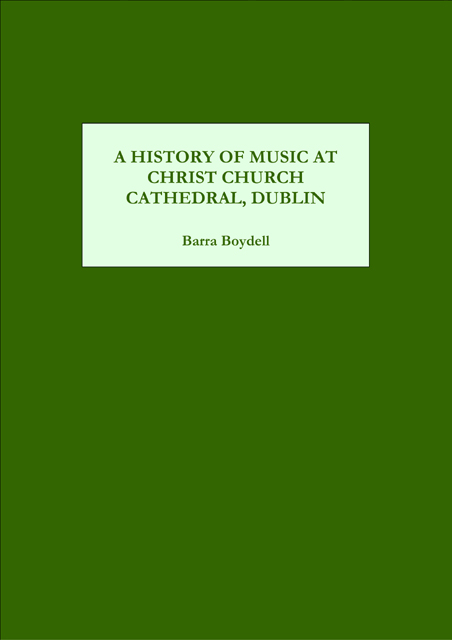Book contents
- Frontmatter
- Contents
- Plates and Musical Examples
- Foreword
- Preface
- Editorial Conventions
- Introduction
- One ‘Dulces Fecit Modos’: The Medieval Cathedral-Priory
- Two ‘For the More Honour of God’s Divine Service’: The Reformation and Early Seventeenth Century
- Three “So Great and Solemn Service’: The Restoration and Later Seventeenth Century
- Four ‘The Increasing Excellence of the Choir’: The Eighteenth and Early Nineteenth Centuries
- Five ‘A More Efficient Performance of the Duties of the Choir’: The Mid-Nineteenth Century
- Six Decline and Revival: Disestablishment and the Twentieth Century
- Appendix One Succession Lists of Organists and Assistant Organists
- Appendix Two Succession List of Masters of the Boys/Music Masters/Choir Masters
- Abbreviations and Bibliography
- Index
Five - ‘A More Efficient Performance of the Duties of the Choir’: The Mid-Nineteenth Century
Published online by Cambridge University Press: 21 March 2023
- Frontmatter
- Contents
- Plates and Musical Examples
- Foreword
- Preface
- Editorial Conventions
- Introduction
- One ‘Dulces Fecit Modos’: The Medieval Cathedral-Priory
- Two ‘For the More Honour of God’s Divine Service’: The Reformation and Early Seventeenth Century
- Three “So Great and Solemn Service’: The Restoration and Later Seventeenth Century
- Four ‘The Increasing Excellence of the Choir’: The Eighteenth and Early Nineteenth Centuries
- Five ‘A More Efficient Performance of the Duties of the Choir’: The Mid-Nineteenth Century
- Six Decline and Revival: Disestablishment and the Twentieth Century
- Appendix One Succession Lists of Organists and Assistant Organists
- Appendix Two Succession List of Masters of the Boys/Music Masters/Choir Masters
- Abbreviations and Bibliography
- Index
Summary
If the opening decades of the nineteenth century had witnessed a decline in the status and fortunes of Christ Church cathedral, those following the passing of the Church Temporalities Act in 1833 would see that process continued to the point where the cathedral’s very survival would be cast into doubt. The Protestant domination of politics was on the decline and Ireland’s Anglican cathedrals now occupied an increasingly marginal place within the country as a whole. Freed from the repressive legislation of previous centuries, the majority of the population could now openly express its Catholic identity and new cathedrals were built throughout the country to serve the re-established, Catholic diocesan system. Although a significant proportion of Dublin’s wealth remained in the hands of the Protestant minority, the presence of two cathedrals within the city began to be called into question. But it is to the credit of Dean Henry Pakenham of St Patrick’s (who assumed the deanery of Christ Church in 1846 under the terms of the Church Temporalities Act) that he proved assiduous in carrying out his additional duties as dean of Christ Church and maintained its independent role where otherwise it might have been subsumed under the shadow of its sister cathedral. The recommendation in a report of the royal commissioners in 1868 that Christ Church be reduced to the status of a parish church, a move which might have brought with it an end to Christ Church cathedral’s musical tradition, was not carried out, but growing political pressure for the Church of Ireland to be disestablished culminated in the Irish Church Act of 1869. Not only was the Church of Ireland’s privileged (but by now quite anomalous) position as the established church removed but it was also largely disendowed: from the point of view of music at Christ Church this would mean that the vicars choral would no longer constitute a corporate body owning properties which, together with the ‘augmentation estate’ established by Charles II (now also to be annulled), had provided the exceptional salaries that had attracted leading singers to the choir.
The radical changes which were to take place in the organisation of the cathedral during the nineteenth century were paralleled by equally profound changes in its physical structure.
- Type
- Chapter
- Information
- A History of Music at Christ Church Cathedral, Dublin , pp. 150 - 171Publisher: Boydell & BrewerPrint publication year: 2004



